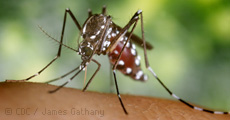# 6365
While once thought of as something only a problem to tropical or semi-tropical regions, mosquito borne diseases like Malaria, Dengue, and Chikungunya increasingly pose a threat to parts of Europe as well.
A few recent examples:
- Last year the CDC issued a travel announcement for Greece regarding a few cases of autochthonous P. Vivax malaria transmission that had been reported over the previous months (see ECDC: Local Malaria Acquisition In Greece).
- In 2011 the HPA (Health Protection Agency) reported on the rapidly increasing number of imported Dengue cases into the UK (see Dengue fever cases double among UK travellers).
- In 2007, a traveler returning from India imported Chikungunya into Northern Italy, resulting in the infection of nearly 300 residents (for details see It's A Smaller World After All).
The list of mosquito-borne diseases that could in the future (or already do) threaten parts of Europe go beyond the three mentioned above, and includes West Nile Virus, Zika Virus, Yellow Fever, Ockelbo virus, and even Rift Valley Fever.
In 2010 the journal Eurosurveillance devoted an entire issue to The Threat Of Vector Borne Diseases, with perhaps the biggest threat outlined in Yellow fever and dengue: a threat to Europe? by P Reiter.
Complicating matters, as global climate change occurs, and as mosquito species are spread inadvertently through the movement of trade goods, ships, and airplanes, new – potentially invasive – mosquito species are being introduced into Europe.
Accordingly, it was announced last year that in 2012 the ECDC will produce guidelines to assist Member States in implementing invasive mosquito vector surveillance.
Today, as part of that ongoing process, the ECDC has released a review of the public health ramifications of invasive mosquitoes in Europe.
Review of status and public health importance of invasive mosquitoes in Europe
30 Apr 2012
ECDC
Invasive mosquito species in Europe present a potential public health threat and their surveillance and control are essential, concludes an article published this week in the journal ‘Vector-borne and zoonotic diseases’, funded and co-authored by ECDC.
The article provides a review of the current geographic spread (pathways for importation and onward dissemination), public health risks related to disease transmission, biology and climatic conditions and control methods of the invasive mosquitoes in Europe.
In the recent years six non-European Aedes mosquitoes (Aedes albopictus, Aedes aegypti, Aedes japonicus, Aedes atropalpus, Aedes koreicus, Aedes triseriatus) have been imported in Europe through the international trade and some of these species are established and spread in Europe.
The invasive mosquito species present a public health risk, as they can be vectors for a number of pathogens. While there is no proof that they could all transmit diseases, there is a potential risk linked to the presence of such mosquito species in Europe, concludes the article. Recent outbreaks of mosquito-borne disease - the chikungunya fever in Italy in 2007 and subsequent autochthonous cases of dengue fever in France and Croatia in 2010 - confirms this threat . This risk can increase in the future, state the authors, due to geographical establishment of the mosquito species in Europe, more frequent travel, and more favourable climatic conditions.
That is why, surveillance and control of the exotic mosquito species in Europe are essential. ECDC through VBORNET (a network of European medical entomologists and public health experts) (link to VBORNET) generates updated quarterly maps of the current distribution status of the exotic mosquito species in Europe (link to maps) - based on a compilation of existing data from various sources. Information exchange between medical entomologists, public health professionals responsible for managing disease outbreaks and policymakers is needed to improve preparedness for vector-borne diseases.
ECDC will produce in 2012 guidelines to assist the Member States to implement invasive mosquito vector surveillance (link to Mosquito guidelines page) and improve coverage and harmonization of data collection within the EU.
Read the article – published in Vector-borne and zoonotic diseases and openly accessible:
A Review of the Invasive Mosquitoes in Europe: Ecology, Public Health Risks, and Control Options, Jolyon M. Medlock, Kayleigh M. Hansford, Francis Schaffner, Veerle Versteirt, Guy Hendrickx, Herve Zeller, and Wim Van Bortel5, Vector-borne and zoonotic diseases, Volume 12, Number XX, 2012Read more:
Aedes aegypti
Aedes albopictus
Aedes japonicus
Mosquito guidelines
Vector-borne diseases
Emerging and Vector-borne Diseases Programme
While today’s report focuses on Europe, the problem of new invasive mosquito species – and the spread of vector-borne diseases into new territories – is of global concern.
A few of my blogs on the threats to North America include:
EID Journal:Vector-Borne Infections
Florida: Locally Acquired Malaria Case Suspected
ASTMH: Dengue and Insect-Borne EIDs In The US
MMWR: Dengue Fever In Key West
Eastern Equine Encephalitis (EEE)
Related Post:
Widget by [ Iptek-4u ]

